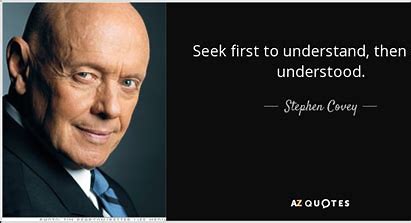Lyle Sussman and David Dubofsky
“Seek first to understand, then be understood.”
This fifth of seven habits of highly effective people, as laid out in Stephen Covey’s bestselling book, is crucial for financial advisors who aspire to communicate effectively with clients and to obtain client referrals.
But although many advisors implicitly accept the power and wisdom of this habit, they often fall short in its execution, and thus may lose clients and leave referrals on the table.
Of course, advisors want to communicate effectively with clients, and may be trained to follow specific communication protocols. But the give-and-take between financial advisor and client is inherently fraught with communication barriers. After all, the encounter is not between algorithm and algorithm, but between one human being and another, each with a persona, style and agenda. And remember, the client was not trained on the advisor’s protocol. Thus, the fidelity between your intended meaning and its interpretation by the client should not be assumed.
In addition, the language and jargon of finance is drawn from economics, banking, mathematics, accounting and the tax code, the confluence of which is undoubtedly a foreign language to many clients. Thus, your intent to be clear, concise and precise could be received as little more than babble by your client.
The following five prescriptions are designed to bridge intent with results. Yes, sometimes noble intentions do indeed produce noble results if they are aligned with actionable behaviors. Each prescription applies this model and if followed by actionable to-do’s.
Prescription No. 1: Understand that the dialogue is not always a 50-50 proposition.
The best financial advice addresses specific client issues at specific points in time. Fully recognizing and addressing those issues means you should usually spend more time listening than speaking. If a timekeeper measured the relative time you and the client spoke, the split should be at least 60/40 — weighted toward the client. This weighting is especially important during the initial meeting when you are trying to assess a client’s dreams, fears, goals and constraints. As the relationship and issues evolve over time, the relative weighting may change.
Prescription No. 2: Understand that the client’s nonverbal behavior is indeed telling you something.
Effective advisors listen with their eyes as well as their ears. They focus on the client’s nonverbal behavior — gestures, tone of voice, posture, facial expressions, fidgeting, eye contact — to help them interpret what the client is feeling, but not explicitly sharing. ”Reading your client” means much more than analyzing their financial status, it also means concentrating on their body language. If you sense a disconnect between what they are saying verbally and what you are reading from their non-verbal cues, acknowledge the disconnect. And yes, a client who ignores your calls and emails is indeed talking to you.
Prescription No. 3: Understand that the best communication media and channels may differ among clients.
Just as you have preferences for sending and receiving messages (email, face to face, phone, computer-mediated), so too will your clients. Rather than assuming or imposing a mode of client communication, ask them for their preferences — and then adapt. Make it their call, not yours. The caveat to this prescription: make sure that decisions are followed by a written validation of mutual agreement.
Prescription No. 4: Understand that graphs, charts, tables and spreadsheets do not speak for themselves.
Use graphs to clarify and simplify; to express, not impress. Data displays are your tools of the trade. When using them, provide context: What are you displaying? What story are they telling? Why is that story important to the client? Finally, validate your client’s understanding. For displays that are particularly complex, ask your clients to tell you what they think the graphs and charts are saying.
Prescription No. 5: Understand that trust is the make-or-break factor in the relationship.
You don’t have to be a silver-tongued orator or a Power Point magician to create trust. But you do have to be honest, consistent, comprehensible, and reliable. There are two tests for earning that trust. You must follow through on everything you say you will do. Following through also means proactively anticipating a client’s fears and addressing them.
Secondly, you may hear things from clients they would normally share with their clergy or therapist. When clients talk about their money, they will also talk about themselves and their family — the good, the bad, and the ugly. Listen empathically, with an open heart and open mind, and maintain strict confidentiality. If what you’re learning about a client requires professional intervention (legal, medical, psychological) tell them so. Financial planning is necessarily life planning. Assuming no conflict of interest, recommend a vetted professional.
Conclusion
The phrase “How to Improve Communication with Clients” yields 1.6 million Google hits. The five prescriptions above are in many ways a distillation of those hits, because they reflect the essence of one of Covey’s transcendent truths for personal and interpersonal effectiveness.
You will effectively communicate with clients when what, how, and why you say what you say reflects an awareness and appreciation for validating what your clients need to hear and understand.
A version of this paper was published by Financial Planning at https://www.financial-planning.com/opinion/5-ways-to-bridge-the-communication-gap-with-clients .
The Authors
David Dubofsky, PhD, CFA, is co-author of Your Total Wealth: The Heart and Soul of Financial Literacy. He is also the author of over 40 academic articles. Previously, he taught finance at Texas A&M University, Virginia Commonwealth University and University of Louisville.
Lyle Sussman, PhD, is Professor Emeritus, College of Business, University of Louisville. He previously taught at University of Michigan and University of Pittsburgh. He is a frequent speaker in the banking industry and co-author of Your Total Wealth: The Heart and Soul of Financial Literacy.

